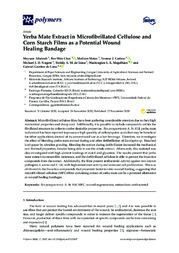Yerba mate extract in microfibrillated cellulose and corn starch films as a potential wound healing bandage.
Yerba mate extract in microfibrillated cellulose and corn starch films as a potential wound healing bandage.
Summary: Microfibrillated cellulose films have been gathering considerable attention due to their high mechanical properties and cheap cost. Additionally, it is possible to include compounds within the fibrillated structure in order to confer desirable properties. Ilex paraguariensis A. St.-Hil, yerba mate leaf extract has been reported to possess a high quantity of caffeoylquinic acids that may be beneficial for other applications instead of its conventional use as a hot beverage. Therefore, we investigate the effect of blending yerba mate extract during and after defibrillation of Eucalyptus sp. bleached kraft paper by ultrafine grinding. Blending the extract during defibrillation increased the mechanical and thermal properties, besides being able to use the whole extract. Afterwards, this material was also investigated with high content loadings of starch and glycerine. The results present that yerba mate extract increases film resistance, and the defibrillated cellulose is able to protect the bioactive compounds from the extract. Additionally, the films present antibacterial activity against two known pathogens S. aureus and E. coli, with high antioxidant activity and increased cell proliferation. This was attributed to the bioactive compounds that presented faster in vitro wound healing, suggesting that microfibrillated cellulose (MFC) films containing extract of yerba mate can be a potential alternative as wound healing bandages.
Publication year: 2020
Types of publication: Journal article
Unit: Embrapa Forestry
Observation
Some of Embrapa's publications are published as ePub files. To read them, use or download one of the following free software options to your computer or mobile device. Android: Google Play Books; IOS: iBooks; Windows and Linux: Calibre.
Access other publications
Access the Agricultural Research Database (BDPA) to consult Embrapa's full library collection and records.
Visit Embrapa Bookstore to purchase books and other publications sold by Embrapa.

